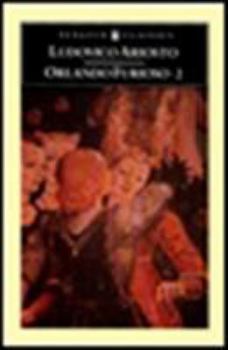Orlando Furioso: A Romantic Epic: Part 2
Select Format
Select Condition 
Book Overview
A dazzling kaleidoscope of adventures, ogres, monsters, barbaric splendor, and romance, this epic poem stands as one of the greatest works of the Italian Renaissance.
Format:Paperback
Language:English
ISBN:014044310X
ISBN13:9780140443103
Release Date:December 1977
Publisher:Penguin Group
Length:800 Pages
Weight:1.30 lbs.
Dimensions:1.6" x 5.1" x 7.8"
Age Range:18 years and up
Grade Range:Postsecondary and higher
Customer Reviews
3 ratings
A Thousand Tales of Derring-Do
Published by Thriftbooks.com User , 16 years ago
Orlando Furioso, translated in two parts by Barabara Reynolds, is a sprawling work. A romance of the Renaissance period (first published in 1516 but written over 25 years), it covers the chivalrous and not-so chivalrous deeds of a huge cast of characters. The themes of the book are love, war and chivalry although one suspects Ariosto, the author, might have just enjoyed telling a good yarn, one tale leading to another in a vast jumble which, while not entirely undirected, only moves gradually towards a rather dimly seen goal. Ariosto picks up from Boiardo's Orlando Innamoratto and assumes the reader has some knowledge of that poem, alluding tangentially to it throughout the work. The basic plot revolves around Charlemagne's defense of France from the Saracens, although, for most of the book, this is just back story. The siege of Paris is described in detail as are several smaller engagements - although their veracity is questionable - but primarily the story follows a panoply of characters through numerous quests, conflicts and magical interludes. The tales are drawn from many sources, contemporary to the time as well as historical and mythical. The Greek myths, in particular are woven throughout, although often gloriously unrecognizable. The tale jumps around the world - literally, as characters fly and sail from Europe to Africa, Asia and the newly discovered North America. Even the moon is a destination. The characters range from the well known Orlando (Roland of the Charlemagne legend) and Charlemagne himself, to lesser known lights of the time drawn from other romances. The Saracens and Christians are treated almost equally - at times you have to refer to the dramatis personae to figure out which side an individual is on - and there is very even-handed treatment of both sides. Ariosto also has a rather advanced, for his time, view of women, casting several as military heros every bit the equal of men and giving almost all of his female characters strong, independent roles. No fainting wall-flower princesses here. Even the modern Disney princess pales in comparison to the fierce Marfisa (Saracen and female and a knight) and the magnificent force that is Bradamante. The male characters are also headstrong, proud to a fault and seem more like rutting mountain goats at times, than men. They display few weaknesses, and are always ready for a challenge. The complicated plot seems designed to pit each of the heroes against each other in a complicated play-off scheme worthy of college football. The tale ranges from brutal to poetic with scenes of beauty, nobility, cruelty and violence juxtaposed in close succession. The occasional bawdy interlude lightens the mood occasionally but this is no Decameron. The emphasis here is on chivalry and nobility of heart. Comparisons with Tasso are inevitable but probably unfair. Tasso's work is a much tighter, uniform work which reads more like a modern novel. Ariosto's work, in my opinion, belongs to a
A delightful giant
Published by Thriftbooks.com User , 23 years ago
Ariosto was one of the giants of Renaissance literature, and this was his footprint. Grand, touching, funny, witty, stirring -- as Dryden said of Chaucer, here is the world's plenty. Some of the greatest poets of the next two centuries (Tasso, Spenser, Milton) explicitly attempted to overdo him, and only sometimes succeeded; Byron took as much from Ariosto as he did from Pulci.But don't read this on that account. Read it because it's a delight from start to finish. War, love, and chivalry are the poet's themes, and they're here in all their forms.I don't know Italian, but everyone I've asked who would know assures me Reynolds's translation captures not just the essence but the spirit of the original.(Ignore the reviews that claim that this is a prose translation -- they are from another translation.)
The Web of Ariosto
Published by Thriftbooks.com User , 24 years ago
This is a wonderful flight of fantasy that is full of magic castles, horses that fly (hippogriffs), and such imagination and humor that you never cease to be entertained by it all. You may wonder like I did that: If this is "Part One", where is part two? I was unable to find any such continuation. You have to just enjoy this marvelous tale for what it is.





